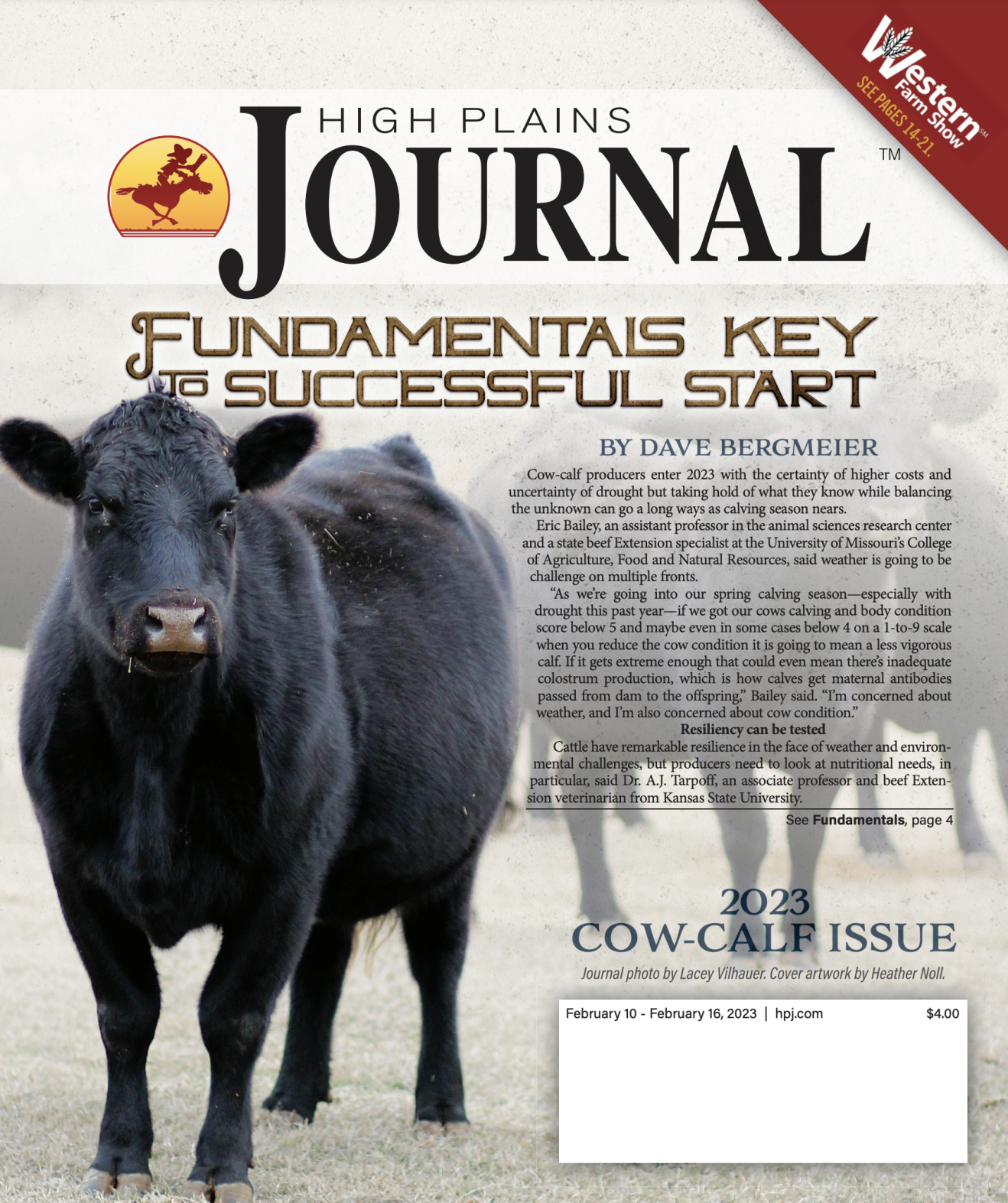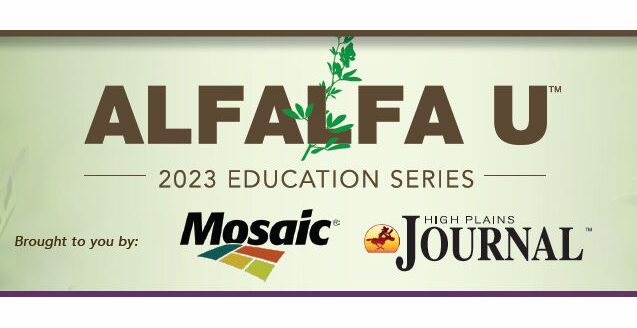Cow-calf producers enter 2023 with the certainty of higher costs and uncertainty of drought but taking hold of what they know while balancing the unknown can go a long ways as calving season nears.
Eric Bailey, an assistant professor in the animal sciences research center and a state beef Extension specialist at the University of Missouri’s College of Agriculture, Food and Natural Resources, said weather is going to be challenge on multiple fronts.
“As we’re going into our spring calving season—especially with drought this past year—if we got our cows calving and body condition score below 5 and maybe even in some cases below 4 on a 1-to-9 scale when you reduce the cow condition it is going to mean a less vigorous calf. If it gets extreme enough that could even mean there’s inadequate colostrum production, which is how calves get maternal antibodies passed from dam to the offspring,” Bailey said. “I’m concerned about weather, and I’m also concerned about cow condition.”
Resiliency can be tested
Cattle have remarkable resilience in the face of weather and environmental challenges, but producers need to look at nutritional needs, in particular, said Dr. A.J. Tarpoff, an associate professor and beef Extension veterinarian from Kansas State University.
“When temperatures drop, their daily intake needs jump up. Producers should be prepared to deliver extra feed to meet energy demands during those stretches,” Tarpoff said. “Wind and wet greatly increase the stress and energy demands of cattle during winter months.”
Cattle weather winter well because of their thick hair coats but what can hurt is when the animals get wet, Bailey said. A High Plains winter day, when it’s 40 degrees Fahrenheit with a 20- to 25-mile an hour wind, that has a quarter inch of rain—even without snow or sleet—that’s some of the worst weather conditions possible for a cow because when the hide gets wet the hair coat gets wet.
“They lose all of that ability to insulate themselves,” Bailey said.
The key is to keep the cow dry because she can stay resilient, he added. “But when she gets wet all bets are off.”
Wind in and of itself is not a major factor, unless it is extreme, because if the cow has a good winter coat and she stays dry that is ideal and gives her the best chance even when the lower critical temperature threshold gets below 20 degrees. “If they get wet forget it.”
Also to deal with cold temperatures a rancher has to be committed to feeding the animals more when it comes to cold stress events. It is not just feeding more hay it is about the animal ending up more calories in total.
“Being willing to supplement them pretty heavily if they are going to get wet. That will go a long way,” Bailey said.
Any opportunity to reduce the stress the extremes put on their herds will pay dividends, Tarpoff said. Natural windbreaks are a luxury in some locations but providing simple windbreaks during times of need can be done with minimal inputs. Stacking large square bales or backing up stock trailers end to end to provide relief from the north and west can be simple strategies for producers to implement, he added.
As for mud, moving feeding areas during the winter and only feeding on well drained locations will help alleviate some of the mud concerns later into the winter.
“Bedding, such as straw or baled corn stalks, are also a great tool to provide a comfortable area to rest,” Tarpoff said. “Bedding provides a thermal barrier from the frozen ground (or mud) that cattle will utilize.”
Bailey also believes windbreaks and temporary shelters help but, like Tarpoff, he stresses the importance of nutrition and overall management.
Colostrum, colostrum, colostrum
Getting that passive transfer of immunity from the mother to the offspring through an adequate dose of that first milk is critical, Bailey said. There are two ways when it does not go well.
Sign up for HPJ Insights
Our weekly newsletter delivers the latest news straight to your inbox including breaking news, our exclusive columns and much more.
“One the cow is thin and when she calves, she doesn’t make a lot of colostrum. Two, she calves thin and the calf is not vigorous and doesn’t want to get up to suck right away.”
In the second case there are products available to help as calf boosters but Bailey believes “you can’t use them as Band-Aid for bad management or for a thin cow.”
Tarpoff said the essential nutrient calves need early in life is colostrum.
“Colostrum is nature’s miracle drug,” the veterinarian said. “It provides newborn calves with all the essentials to get it off to a great start.”
Ideally calves should consume 10% of their body weight in colostrum within the first two to hours of their lives he said. Assessing calf vigor soon after birth and ensuring they are up and suckling will pay dividends on their wellbeing.
Ranchers have rightfully been concerned about their 2023 season because of the sustained drought, he said.
“I know it can be a costly struggle to maintain the body condition score on our cows through the winter months,” Tarpoff said. “Those feed investments will pay off immediately during calving and breeding season this spring.”
Skinny cows have increased rates of dystocia, which means difficulty calving, and decreased volume and quality of colostrum production, Tarpoff said. The skinny cows also have a more difficult time breeding back. Maintaining decent flesh on cows through the winter can increase calf survival rates as well as improve rebreeding early in the breeding season.
Although it might be tempting to cut back on input costs, Tarpoff says to reconsider that approach.
“The old adage ‘an ounce of prevention is better than a pound of cure’ is truer now more than ever,” Tarpoff said. “Focusing the basics of quality nutrition and water, animal comfort and preventative herd health strategies will be the key.”
Getting really good at the basics allows producers to find their own unique efficiencies and then they can advantage of them, he said.
Hay limiting factor
Another weather concern is feed expenses, particularly as hay prices have increased in many regions of the High Plains, Bailey said.
“I’ve seen round bales of prairie hay that are being sold for over $150 a bale in central and eastern Kansas,” Bailey said. “I can only imagine that the pricing on hay and other stored forages just gets extreme the farther west you go. We’re in a no-win because you don’t necessarily want to spend $3 to $4 a cow a day on feed you can’t pencil that for any meaningful amount of time but at the same token you’ve got a $1,100 to $1,200 calf in her belly right now. Unfortunately, calf prices are going up but it does seem like profits are not going up because input costs have gone up so much. For me, feeding them and keeping them in a body condition score of at least a 5 if you can.”
As producers evaluated costs that started during last year there was a tendency to reduce fertilizer application in pastures and on hay crops and that reduced forage availability.
“Some guys started feeding hay here (in Missouri) in October when they normally would have started feeding that around Thanksgiving into early December,” Bailey said. “Now we’re getting to the point where our have inventory looks more like it would on St. Patrick’s Day.”
The demand for hay is still high, he said, and that drives up costs and the farther west it becomes even more pronounced, he said.
“That’s the thing that stinks,” he said. “If you look at the feeder calf market for next August the futures, it’s over two bucks a pound. The futures market is telling us right now that a 550-pound steer next fall is probably going to be worth over $1,100. So, you know, there’s a lot of people that are licking their chops. But the problem is, is that input costs are astronomical right now. A lot of the concerns that people are having are just.”
The bottom line is there is no easy fix, he said.
His advice to cow-calf producers is weigh their options. One example, he said, might be instead of traditionally running 100 head of cows in which a prolonged drought means having to pay for added cost perhaps considering cutting back to 75 and then look at maybe feeding some stocker calves in the summer when there is an opportunity to feed their extra grass while reducing winter input costs.
There is getting to be more research available that can help guide growers and he expects that to continue.
Dave Bergmeier can be reached at 620-227-1822 or [email protected].




